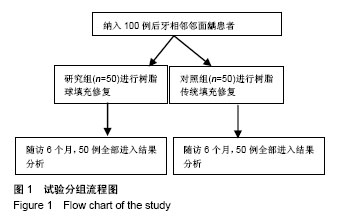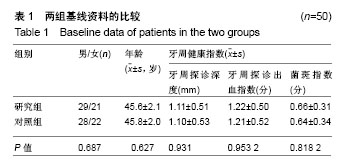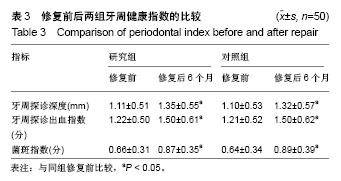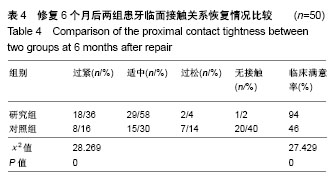| [1] 江娅玲,冯明业,程磊.纳米载药系统防治龋病和牙周病的研究进展[J].华西口腔医学杂志,2017, 35(1):104-107.[2] 何治一,张蓉,张平虎,等.2种复合树脂磨牙充填修复的临床评价[J].牙体牙髓牙周病学杂志,2016, 26(4):240-244.[3] Nugala B,Kumar BS,Sahitya S,et al.Biologic width and its importance in periodontal and restorative dentistry.J Conserv Dent.2012;15(1):12-17.[4] 钟波,范兵,刘莉霞.应用三种成形片树脂充填邻(牙合)面洞的临床评价[J].实用医学杂志,2011, 27(21):3891-3892.[5] Opdam NJ, Bronkhorst EM,Roeters JM.A retrospective clinical study on longevity of posterior composite and amalgam restorations.Dent Mater.2007;23(1):2-8. [6] 谭忠荣,陈丽,谢三祥,等.光固化复合树脂在牙冠缺损修复中的应用可行性[J].基因组学与应用生物学, 2016,38(10):2609-2613.[7] 陈萍.龈沟液中MMP-8及TIMP-1水平与牙周病的关系[D].河北医科大学,2011.[8] 于鑫,李明恒,邱伟.不同邻面成形系统对后牙邻(牙合)面洞树脂修复的临床应用评价[J].中国医药指南,2016, 14(15):25-26.[9] 陈博.可注射细胞微球明胶复合物联合血小板裂解液在牙组织工程中的应用研究[D].第四军医大学,2015.[10] 张蓉,郭静,南小梅.Palodent在成对后牙邻面成形的临床评价[J].口腔医学研究,2015,31(3):280-282.[11] 程俊歌,张智玲,王晓燕,等.数字口内X线片和口腔颌面锥形束CT对邻面龋诊断准确性的研究[J].中华口腔医学杂志, 2011,46(s1):1-5.[12] 边专,范兵.我国牙髓病治疗的现状分析[J].中华口腔医学杂志, 2011, 46(12):717-720.[13] 孔霞.北京市某三甲医院口腔科就诊者口腔卫生习惯调查[J].中国健康教育,2016,32(6):523-525.[14] 程莉.银汞合金与后牙复合树脂用于乳磨牙龋齿充填治疗的临床观察[J].检验医学与临床,2012, 9(3):382-383.[15] 梁继超,王芬,张正华,等.正畸分牙辅助邻面龋充填治疗的临床疗效观察[J].国际口腔医学杂志,2017, 44(4):440-444.[16] 申郁荣.非创伤性充填技术治疗楔状缺损的疗效评价[J].中国卫生统计,2015,32(6):1102-1102.[17] 周峥,邓卓峰.不同材料修复楔形缺损的疗效及其影响因素[J].山东医药,2016,56(33):89-91.[18] 赵玉龙,杨德圣.生物活性玻璃抑制酸蚀后不同时间牙釉质的刷牙磨损[J].中国组织工程研究,2015, 19(25):4022-4026.[19] 张杰,宗锦飞.不同充填材料对后牙邻面龋齿充填治疗的临床研究[J].医药前沿,2015,5(35):64-65.[20] Kurbad A,Ganz S,Kurbad S.CAD/CAM generated all-ceramic primary telescopic prostheses.Int J Comput Dent. 2012;15(3): 237-249.[21] Magne P,Paranhos MP,Schlichting LH.Influence of material selection on the risk of inlay fracture during pre-cementation functional occlusal tapping.Dent Mater.2011;27(2):109-113.[22] 骆小平.不同瓷修复体基牙预备特点[J].中国实用口腔科杂志, 2009, 2(1):21-25.[23] 葛光华,袁鸽成,江小平,等.Grandio纳米树脂与可乐丽树脂充填治疗后牙深龋的疗效比较[J].口腔疾病防治, 2015,23(5):264-267.[24] 程德盛.光固化复合树脂修复成人正畸牙冠缺损的可行性[J].中国组织工程研究,2016,20(21):3051-3056.[25] 沈艳,刘晓.复合树脂多层修复术和间接导板技术在前牙间隙美容修复的临床应用[J].口腔医学研究,2015, 31(9):910-912.[26] 张珑,李芳萍,杨柏松,等.不同材料嵌体修复邻牙合(II 类)洞型的应力影响分析[J].实用口腔医学杂志, 2015(5):627-632.[27] 陈吉华,熊宇.微创牙科学的发展(二)——微创牙科学的临床效果及推广应用[J].实用口腔医学杂志,2006, 22(3):426-430.[28] 刘永红,葛立宏,张志勇,等.渗透树脂在乳磨牙邻面龋损中渗透能力的实验研究[J].中华口腔医学杂志, 2012,47(11):684-688.[29] 杨团结,谭志红,钟瑾,等.Carisolv去腐结合复合树脂治疗龋齿的评价[J].实用口腔医学杂志,2007, 23(2):292-293.[30] 王卫华.树脂修复材料理化特征及其在龋齿临床应用中的评价[J].中国组织工程研究,2010, 14(16):2983-2986.[31] 罗云,任杰,LuoYun,等.临床食物嵌塞病症的常见病因分析及序列治疗[J].国际口腔医学杂志,2016,43(1):1-4.[32] 黄敏,罗云,王敏.相邻牙间的邻面接触与食物嵌塞的关系[J].国际口腔医学杂志,2016,43(3):303-308.[33] 徐正茂,刘敏,田立华.难治性牙周炎患者血清中瘦素(LEP)水平及其与牙周临床指数关系分析[J].口腔医学研究, 2016,32(7):760-763.[34] 方碧松,徐爱凤,徐娟.树脂球法恢复二类洞邻面接触关系的临床研究[J].现代口腔医学杂志,2008, 22(5):453-455.[35] Feinman RA.The plunging ball technique: Class II direct composite resins.Pract Periodontics Aesthet Dent. 1992;4(5): 43-48.[36] 雍颹,张润荃.Palodent后牙邻面成形系统的临床应用[J].华西口腔医学杂志,2009,27(1):44-48.[37] 王东杰,吴兵,陈晓红.光固化复合树脂前牙微创美学修复的临床体会[J].国际口腔医学杂志,2014, 41(2):137-139.[38] 黎耀荣,周禹雄,刘瑜容.双步成形直接树脂充填法重建邻牙合面洞邻接关系初步研究[J].牙体牙髓牙周病学杂志, 2012,22(11):659-661. |
.jpg)





.jpg)